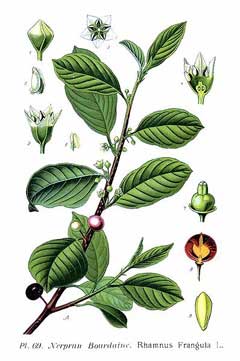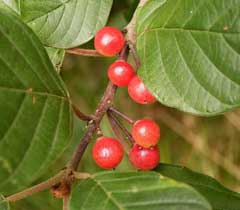 |
|
http://commons.wikimedia.org/wiki/File:69_Rhamnus_Frangula_L.jpg |
 |
| http://commons.wikimedia.org/wiki/User:Ies |
Translate this page:
Summary
UPDATE 15/3/2012: Rhamnus frangula L. is a synonym of Frangula dodonei Ard.
Physical Characteristics

 Rhamnus frangula is a deciduous Shrub growing to 5 m (16ft) by 4 m (13ft) at a slow rate.
Rhamnus frangula is a deciduous Shrub growing to 5 m (16ft) by 4 m (13ft) at a slow rate.
See above for USDA hardiness. It is hardy to UK zone 3. It is in flower from May to June, and the seeds ripen from September to November. The species is hermaphrodite (has both male and female organs) and is pollinated by Insects.
It is noted for attracting wildlife.
Suitable for: light (sandy), medium (loamy) and heavy (clay) soils. Suitable pH: mildly acid, neutral and basic (mildly alkaline) soils. It can grow in semi-shade (light woodland) or no shade. It prefers moist or wet soil.
UK Hardiness Map
US Hardiness Map
Synonyms
Frangula alnus. Mill. Frangula dodonei
Plant Habitats
Woodland Garden Sunny Edge; Dappled Shade; Shady Edge; Hedge; Bog Garden;
Edible Uses
References More on Edible Uses
Medicinal Uses
Plants For A Future can not take any responsibility for any adverse effects from the use of plants. Always seek advice from a professional before using a plant medicinally.
Aperient Cathartic Cholagogue Laxative Purgative Tonic Vermifuge
Alder buckthorn has been used medicinally as a gentle laxative since at least the Middle Ages[244]. The bark contains 3 - 7% anthraquinones, these act on the wall of the colon stimulating a bowel movement approximately 8 - 12 hours after ingestion[254]. It is so gentle and effective a treatment when prescribed in the correct dosages that it is completely safe to use for children and pregnant women[244]. The bark also contains anthrones and anthranols, these induce vomiting but the severity of their effect is greatly reduced after the bark has been dried and stored for a long time[254]. The bark is harvested in early summer from the young trunk and moderately sized branches, it must then be dried and stored for at least 12 months before being used[4, 238] The inner bark is cathartic, cholagogue, laxative (the fresh bark is violently purgative), tonic, vermifuge[4, 9, 13, 21, 165]. It is taken internally as a laxative for chronic atonic constipation and is also used to treat abdominal bloating, hepatitis, cirrhosis, jaundice, and liver and gall bladder complaints[238]. It should be used with caution since excess doses or using the bark before it is cured can cause violent purging[9, 21]. Externally, the bark is used to treat gum diseases and scalp infestations[238], or as a lotion for minor skin irritations[244]. The fruit is occasionally used, it is aperient without being irritating[4]. The German Commission E Monographs, a therapeutic guide to herbal medicine, approve Rhamnus frangula for constipation (see [302] for critics of commission E).
References More on Medicinal Uses
The Bookshop: Edible Plant Books
Our Latest books on Perennial Plants For Food Forests and Permaculture Gardens in paperback or digital formats.

Edible Tropical Plants
Food Forest Plants for Hotter Conditions: 250+ Plants For Tropical Food Forests & Permaculture Gardens.
More

Edible Temperate Plants
Plants for Your Food Forest: 500 Plants for Temperate Food Forests & Permaculture Gardens.
More

More Books
PFAF have eight books available in paperback and digital formats. Browse the shop for more information.
Shop Now
Other Uses
Charcoal Dye Hedge Hedge Nails Wood
A yellow dye is obtained from the leaves and bark[4, 115]. It is much used in Russia and turns black when mixed with salts of iron[4]. A green dye is obtained from the unripe fruit[4, 115]. A blue or grey dye is obtained from the ripe berries[4, 115]. Plants can be grown as an informal (untrimmed) hedge, though they are also amenable to trimming[200]. The cultivar 'Tallhedge (syn 'Columnaris') is very suitable for this purpose[200]. The wood is used to make wooden nails, shoe lasts, veneer etc[46, 61]. It is the source of a high quality charcoal that is used by artists[4, 11, 13, 17, 100, 115, 182, 186].
Special Uses
Attracts Wildlife Food Forest Hedge Hedge
References More on Other Uses
Cultivation details
An easily grown plant, it succeeds in any reasonably good soil[11, 98], preferring neutral to acid conditions[238]. It grows well on damp or peaty soils[98]. Prefers a moist moderately fertile soil in sun or semi-shade[200]. Grows well in wet soils but not if they are water-logged[186]. Dislikes drought or exposure to strong winds[186]. Plants are hardy to at least -15°c[238]. Alder buckthorn is a slow-growing plant, though it coppices well. It was at one time often grown for its wood which was used in making charcoal[186]. The plants regenerate well after forest fires or grazing[186]. Plants flower on one-year old wood and also on the current year's growth[4]. Cultivated as a medicinal plant in S. Europe[57]. Often bears the aecidospore stage of 'crown rust' of oats[1]. The species in this genus are notably resistant to honey fungus[200]. A good bee plant[4] and a main food plant for the larvae of the yellow brimstone butterfly[186]. In garden design, as well as the above-ground architecture of a plant, root structure considerations help in choosing plants that work together for their optimal soil requirements including nutrients and water. The root pattern is suckering with new plants from underground runners away from the plant [2-1].
References Carbon Farming Information and Carbon Sequestration Information
Temperature Converter
Type a value in the Celsius field to convert the value to Fahrenheit:
Fahrenheit:
The PFAF Bookshop
Plants For A Future have a number of books available in paperback and digital form. Book titles include Edible Plants, Edible Perennials, Edible Trees,Edible Shrubs, Woodland Gardening, and Temperate Food Forest Plants. Our new book is Food Forest Plants For Hotter Conditions (Tropical and Sub-Tropical).
Shop Now
Plant Propagation
Seed - best sown in the autumn in a cold frame. Stored seed will require 1 - 2 months cold stratification at about 5° and should be sown as early in the year as possible in a cold frame or outdoor seedbed[200]. Germination is usually good, at least 80% by late spring. Prick out the seedlings into individual pots when they are large enough to handle, and grow them on in the greenhouse or cold frame for their first winter. Plant them out in late spring or early summer of the following year. Cuttings of half-ripe wood, July/August in a frame[113]. Cuttings of mature wood of the current year's growth, autumn in a frame. Layering in early spring[4].
Other Names
If available other names are mentioned here
Native Range
TEMPERATE ASIA: Iran (north), Iraq (north), Syria (north), Turkey, Russian Federation-Ciscaucasia (Ciscaucasia), Armenia, Azerbaijan, Georgia, Russian Federation (Dagestan), Russian Federation-Western Siberia (Western Siberia), Russian Federation-Eastern Siberia (Eastern Siberia), Russian Federation (Altay), Kazakhstan, China (Xinjiang Uygur Zizhiqu (north)) EUROPE: Denmark, Finland, United Kingdom, Ireland, Norway, Sweden, Czechoslovakia, Austria, Belgium, Switzerland, Germany, Hungary, Netherlands, Poland, Russian Federation (European part), Belarus, Estonia, Lithuania, Latvia, Moldova, Ukraine (incl. Krym), Former Yugoslavia, Albania, Bulgaria, Greece, Italy, Romania, Spain, France (incl. Corsica), Portugal AFRICA: Algeria (north), Morocco, Tunisia
Weed Potential
Right plant wrong place. We are currently updating this section.
Please note that a plant may be invasive in one area but may not in your area so it's worth checking.
Conservation Status
IUCN Red List of Threatened Plants Status :

Growth: S = slow M = medium F = fast. Soil: L = light (sandy) M = medium H = heavy (clay). pH: A = acid N = neutral B = basic (alkaline). Shade: F = full shade S = semi-shade N = no shade. Moisture: D = dry M = Moist We = wet Wa = water.
Now available:
Food Forest Plants for Mediterranean Conditions
350+ Perennial Plants For Mediterranean and Drier Food Forests and Permaculture Gardens.
[Paperback and eBook]
This is the third in Plants For A Future's series of plant guides for food forests tailored to
specific climate zones. Following volumes on temperate and tropical ecosystems, this book focuses
on species suited to Mediterranean conditions—regions with hot, dry summers and cool, wet winters,
often facing the added challenge of climate change.
Read More
Expert comment
Author
L.
Botanical References
1117200
Links / References
For a list of references used on this page please go here
Readers comment
| Add a comment |
|
If you have important information about this plant that may help other users please add a comment or link below. Only comments or links that are felt to be directly relevant to a plant will be included. If you think a comment/link or information contained on this page is inaccurate or misleading we would welcome your feedback at [email protected]. If you have questions about a plant please use the Forum on this website as we do not have the resources to answer questions ourselves.
* Please note: the comments by website users are not necessarily those held by PFAF and may give misleading or inaccurate information.
To leave a comment please Register or login here All comments need to be approved so will not appear immediately.
|
Subject : Rhamnus frangula
|
|
|
|